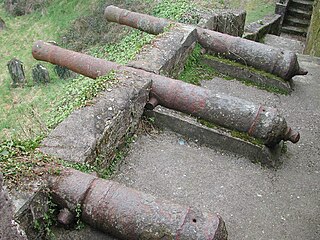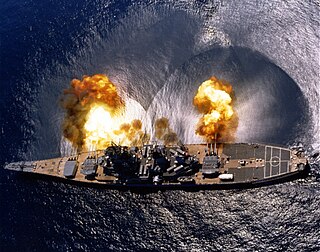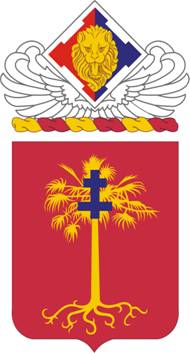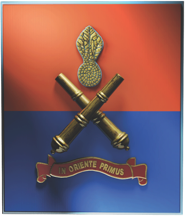
Artillery are ranged weapons that launch munitions far beyond the range and power of infantry firearms. Early artillery development focused on the ability to breach defensive walls and fortifications during sieges, and led to heavy, fairly immobile siege engines. As technology improved, lighter, more mobile field artillery cannons developed for battlefield use. This development continues today; modern self-propelled artillery vehicles are highly mobile weapons of great versatility generally providing the largest share of an army's total firepower.

In military organizations, an artillery battery is a unit or multiple systems of artillery, mortar systems, rocket artillery, multiple rocket launchers, surface-to-surface missiles, ballistic missiles, cruise missiles, etc., so grouped to facilitate better battlefield communication and command and control, as well as to provide dispersion for its constituent gunnery crews and their systems. The term is also used in a naval context to describe groups of guns on warships.

Naval gunfire support (NGFS), also known as naval surface fire support (NSFS), or shore bombardment, is the use of naval artillery to provide fire support for amphibious assault and other troops operating within their range. NGFS is one of several disciplines encompassed by the term naval fires. Modern naval gunfire support is one of the three main components of amphibious warfare assault operations support, along with aircraft and ship-launched land-attack missiles. Shipborne guns have been used against shore defences since medieval naval warfare.

In military science, suppressive fire is "fire that degrades the performance of an enemy force below the level needed to fulfill its mission". When used to protect exposed friendly troops advancing on the battlefield, it is commonly called covering fire. Suppression is usually only effective for the duration of the fire. It is one of three types of fire support, which is defined by NATO as "the application of fire, coordinated with the maneuver of forces, to destroy, neutralise or suppress the enemy".

An artillery observer, artillery spotter, or forward observer (FO) is a soldier responsible for directing artillery and mortar fire support onto a target. An artillery observer usually accompanies a tank or infantry unit. Spotters ensure that indirect fire hits targets which those at a fire support base cannot see.
Counter-battery fire is a battlefield tactic employed to defeat the enemy's indirect fire elements, including their target acquisition, as well as their command and control components. Counter-battery arrangements and responsibilities vary between nations but involve target acquisition, planning and control, and counter-fire. Counter-battery fire rose to prominence in World War I.

The Field Artillery Branch is the field artillery branch of the United States Army. This branch, alongside the Infantry and Cavalry branches, was formerly considered to be one of the "classic" combat arms branches, but is today included within the "Maneuver, Fires and Effects" (MFE) classification, in accordance with current U.S. Army organizational doctrine.

Field artillery is a category of mobile artillery used to support armies in the field. These weapons are specialized for mobility, tactical proficiency, short range, long range, and extremely long range target engagement.

The 14th Marine Regiment is a reserve artillery regiment of the United States Marine Corps consisting of three artillery battalions and a headquarters battery. The regiment is based in Fort Worth, Texas however its units are dispersed among 15 different sites in 12 states. Its primary weapon system is the M777A2 Howitzer with a maximum effective range of 30 km however one of its battalions has converted to fire the High Mobility Artillery Rocket System (HIMARS) weapon system.

Fire discipline is a system of communication in the military, primarily for directing artillery. By definition, fire discipline is the language of fire control. It consists of words, phrases, rules, and conventions which have specific meanings and which result in some definite action being taken with the guns. All ranks concerned in fire control must be thoroughly familiar with the language and the resulting actions. The aim of fire discipline is to ensure that in response to calls for fire, the appropriate action is taken at the FPC, FSCC, FDC and at the Guns/MRL, strictly in accordance with the intentions of the originator and with the minimum of delay.

In military usage, a barrage is massed sustained artillery fire (shelling) aimed at a series of points along a line. In addition to attacking any enemy in the kill zone, a barrage intends to suppress enemy movements and deny access across that line of barrage. The impact points along the line may be 20 to 30 yards apart, with the total line length of the barrage zone anything from a few hundred to several thousand yards long. Barrages can consist of multiple such lines, usually about 100 yards apart, with the barrage shifting from one line to the next over time, or several lines may be targeted simultaneously.
The 3rd Field Artillery Regiment is a field artillery regiment of the United States Army, first formed in 1812, although regimental units trace their lineages as far back as 1794. Based on the service of these antecedents, the regiment claims battle honors for the War of 1812, the Seminole campaign, the Mexican War, the Civil War, the Spanish–American War, and the Philippine Insurrection. The regiment served with the 6th Division during World War I, with the 5th Division, 6th Division and 2d Cavalry Division between the world wars, and with the 9th Armored Division during and after World War II. Since 1961, the regiment has been a parent regiment under the Combat Arms Regimental System and the U.S. Army Regimental System, with regimental elements serving with the 1st, 6th, and 8th Infantry Divisions; 2nd and 3rd Armored Divisions; 1st Cavalry Division; 194th Armored Brigade; and various field artillery brigades and groups. Three regimental battalions are currently active: the 2nd Battalion in the 1st Armored Division and the 1st Battalion and 5th Battalion, both a part of the 17th Field Artillery Brigade.

The 36th Field Artillery Regiment is a field artillery regiment of the United States Army.

The 78th Field Artillery Regiment is a regiment of the Field Artillery Branch of the United States Army. Initially activated on 1 July 1916, the 78th Field Artillery Battalion did not see action in World War I, but would later be reactivated at the start of World War II and participate in the campaigns for Algeria-French Morocco, Sicily, Normandy, Northern France, Ardennes-Alsace, Central Europe, and the Rhineland with the 2d Armored Division. The 78th Artillery Battalion's six batteries were reorganized into separate battalions in 1957, with the 1st Battalion, 78th Field Artillery being the only remaining active unit of the 78th Field Artillery.

The 320th Field Artillery Regiment is a field artillery regiment of the United States Army. A parent regiment under the U.S. Army Regimental System, the 320th FAR currently has two active elements in the 101st Airborne Division : 1st Battalion, 320th FAR "Top Guns" in 2nd Brigade Combat Team; and 3rd Battalion, 320th FAR "Red Knight Rakkasans" in 3rd Brigade Combat Team. The regiment served with the 82nd Airborne Division during World Wars I and II, and regimental elements have served with the 82nd and 101st Airborne Division, the 193rd Infantry Brigade and the Berlin Brigade, and conducted combat operations in the Dominican Republic, Vietnam, Grenada, Operations Desert Shield and Storm, and the Global War on Terror.

The 321st Field Artillery Regiment is a field artillery regiment of the United States Army. A parent regiment under the U.S. Army Regimental System, the 321st FAR currently has one active battalion, the 3rd Battalion, 321st FAR, assigned to the 18th Field Artillery Brigade at Fort Liberty, NC. The battalion is equipped with M142 HIMARS.
The regiment served with the 82nd Division during World War I and with the 101st Airborne Division during World War II. Elements of the regiment have served with the 82nd and 101st Airborne Divisions in Vietnam, and with the 82nd Airborne Division and 18th Field Artillery Brigade during the Global War on Terrorism.
Forward observers in the U.S. military are artillery observers who carry the Military Occupational Specialty designator of 13F in the United States Army and 0861 in the United States Marine Corps. They are officially called "joint fire support specialists" in the U.S. Army and "fire support marines" in the U.S. Marine Corps. They are colloquially known as "FiSTers", regardless of whether they are members of a FiST. A battalion fire support officer (FSO) is the officer in charge of a battalion fire support element.
The Bloody Gulch massacre was a war crime that took place in the Korean War on August 12, 1950, in "Bloody Gulch", west of Masan, South Korea. After a successful attack on two US artillery battalions that killed or injured hundreds of US soldiers, North Korea's Korean People's Army (KPA) 13th Regiment then killed 75 US Army prisoners of war. Otherwise this was one of the smaller engagements of the Battle of Pusan Perimeter. The 75 soldiers were from the 555th Field Artillery Battalion of the US 24th Infantry Division and the 90th Field Artillery Battalion of the US 25th Infantry Division.

The Artillery is a formation of the Singapore Army, comprising four active battalions—the 20th, 21st, 23rd and 24th Battalions—and an undisclosed number of reservist battalions. The primary role of the Artillery formation is to deliver timely, accurate and effective fire in support of the manoeuvre force to accomplish missions. As an indirect fire support system, the gunners rely on the forward observer and target acquisition elements to provide the target's location, which is then passed to the command post to direct the gunners to fire.
The 2nd Battalion, 29th Field Artillery Regiment is a unit of the 4th Armor Brigade Combat Team of the 1st Armored Division, United States Army. The battalion is currently garrisoned at Fort Bliss, Texas.















